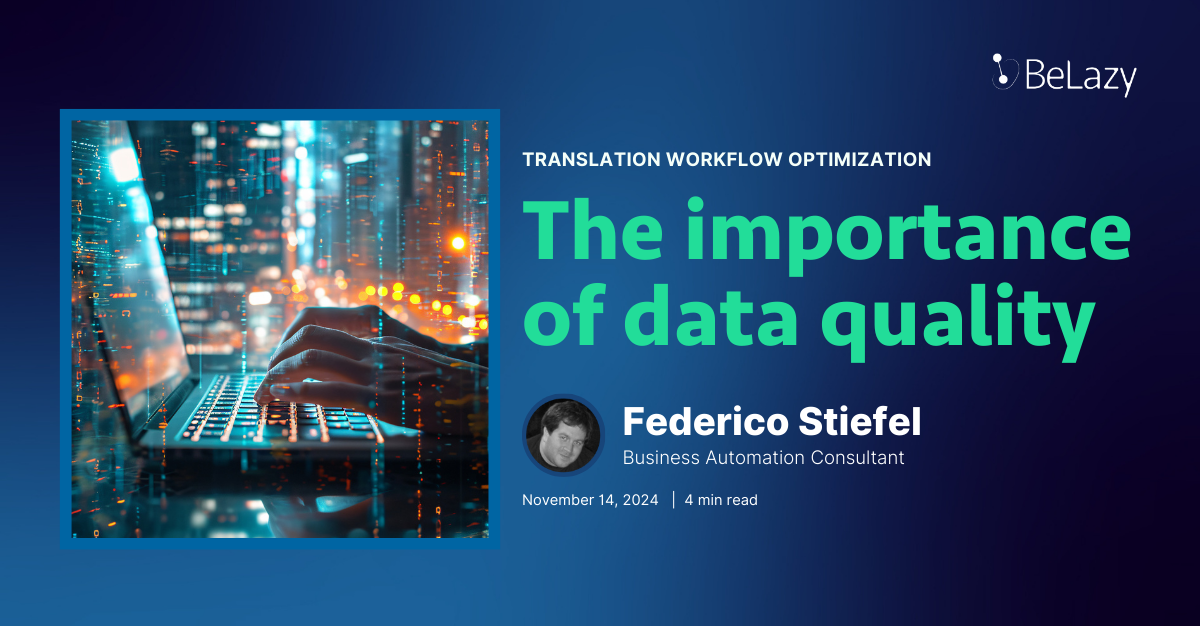It’s no secret by now, BeLazy’s vision is to enable efficient continuous localization across the supply chain. As we work hard towards this goal, we are constantly interviewing translation buyers to understand their needs and technology solutions, and discussing with their multilingual language vendors (MLVs) the inefficiencies that small and repetitive translation jobs represent to the supply chain mesh. While companies at the top of the chain invest a lot of effort and money to integrate their technology stack, those at the bottom of the chain, the so-called single language vendors (SLVs), struggle badly in trying to keep up with the overhead caused by continuous localization methodologies.
In our attempt to understand the logic behind which language services flow across the industry, last December we launched the BeLazy Early Automators Program (BEAP): a collaboration scheme between BeLazy and language service providers (LSPs) that had already identified the need for automation within their organization and were keen to get on board with new initiatives that bring efficiency and cost savings.
We worked closely with each of the LSPs to analyze their supply chain environment and match their needs to BeLazy’s product roadmap. All in all, we identified six different scenarios that show the different collaboration possibilities throughout the translation supply chain. After having drafted and sketched the respective scenarios, our next goal is to enable full automation workflows within BeLazy for each of them.
To our surprise, our findings are much more complex than you and I probably ever thought. Yet, we are committed to raising awareness of the complex bonds that make up the translation supply chain, that is why we will share insights on each of these scenarios on the course of the following months (we are starting with the first one today!). We will explain the challenges that each scenario presents and show how BeLazy has been able to help integrate these platforms and make continuous localization seamless.

EXPLORE SCENARIO 1
We would very much like to have your feedback on the existing scenario and help us identify new ones. And always feel free to reach out to us when you are ready to introduce automation to your organization 😉
Before getting started, we go over this concise dictionary of continuous localization.
What is Continuous Localization?
We see more and more enterprises integrating the copywriting process into the product development lifecycle. This growing trend has led to a series of changes to the traditional translation workflow, some of which are making things easier while others bring on new challenges.
The main characteristics of continuous localization are:
- Handoffs are frequent, contain little content, and the deadlines are tight.
- In an ideal continuous localization setup, the file formats are standardized and designed to purpose. There is no need to engineer files for each handoff but rather set up an automated system that manages the translation workflow based on agreed standards.
- In an automated publishing process, there is no time and need for tedious quoting-approval rounds.
- Projects are not updated as no one would be able to track such updates. And inherently, in continuous localization such updates manifest as new translation jobs.
- Deadlines are dealt with upfront as part of the SLAs, hence the required turn-around time is assumed from both sides.
- The stakeholders agree upon a framework agreement and follow the program KPIs through dashboards.
What does the supply chain look like?
End-client
Translation jobs are (almost) always initiated by the end client — the content owner.
Client
The content is processed by a language service provider — in the case of big companies, the LSP is usually a Multilingual Language Vendor. The content then flows across the supply chain to other stakeholders in the process: the single language vendors, translators and other language professionals such as quality checkers or reviewers.
Automator
The supply chain is usually long and is made up of many different companies, all of which could benefit from BeLazy’s integrations and connectors in the role of automators.
Vendors | Translators
Each automator has a client, the previous stakeholder in the supply chain, but has also vendors. At the end of the supply chain there are translators who could be in-house or freelancers. The shortest supply chain is that which only includes an end client and translators.
What’s an automation scenario?
- A Translation Management System (TMS) takes content from different sources (documents, websites, or even software code) and turns it into a translatable format. TMS's generally support translation workflows but do not necessarily expose the content to the translator. Different TMS's possess different functionality like online translation capabilities, the possibility to create and receive translation packages, provide financial information regarding the document to be translated, or even allow the vendor to request changes in pricing. SDL WorldServer or Globallink are two examples of TMS's worldwide.
- A Business Management System (BMS) takes care of project assignments. Used predominantly by language service providers, it’s the central database to vendor, customer, and pricing management, as well as project flow. It can store and manage projects from multiple translation management systems and those coming via emails. XTRF and Plunet are two of the best-known business management systems in our industry.
- A vendor portal is the vendor-facing interface of a business management system. The platform allows vendors (suppliers) of a translation company to see jobs offered by the business management system. For our purposes it counts as a separate system given it’s the only part of the BMS that is used exclusively by vendors. Vendor portals are usually capable of receiving the translated material back.
- A Computer-Assisted Translation (CAT) tool is a system used by language service providers to process translation jobs. This usually imports translation packages and/or original files. Sometimes people refer to CAT tools and translation management systems alike (for example, Memsource which is used by enterprises and language service providers, is often referred to as both) but typically there is a difference (e.g. SDL Worldserver packages are usually processed in SDL Trados or memoQ). A CAT tool can be online or offline, though we have seen that processing is more efficient with online tools. There isn’t a perfect division between translation management systems and CAT tools, but we distinguish these two on the basis of who deploys it: TMS is used by the buyer, the CAT is used by the vendor (language service provider).
What is an online/offline workflow?
Offline workflow: The content is exported from the client’s systems and arrives to the Automator (language service provider) in different formats such as translation packages, bilingual files, or original files (e.g. Adobe files). The Automator may need to use specific technology to process the file. In this kind of environment, it will be impossible to track if the vendor decides to re-assign the job to other sub-vendors.
Online workflow: The content never leaves the translation management system. The translation job is assigned to the Automator within the system and the vendor uses an application or web browser to work in it — possibly reassigning to sub-vendors if needed. Everything can be tracked within the system.
Scenarios describing the interconnected systems driving continuous localization
BeLazy’s primary goal is to support the workflows built upon standardized processes. The scenarios we present outline some of the most common system setups that an Automator needs to manage when working with its client.
The processes described in these scenarios do not include quoting, price, or deadline negotiation. Do you have projects that meet these characteristics of the continuous localization programs? If yes, sign up to BeLazy now!
If there is a connector missing and this is preventing you from becoming the next Automator, please let us know. Also, do reach out to us if your projects follow a different path: we are very interested to learn about your workflow and see whether it is possible to make your work more efficient.







